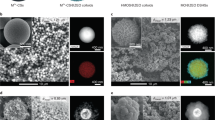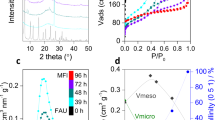Abstract
Zeolites are mainly used for the adsorption and separation of ions and small molecules, and as heterogeneous catalysts. More recently, these materials are receiving attention in other applications, such as medical diagnosis and as components in electronic devices1. Modern synthetic methodologies for preparing zeolites and zeolite-like materials typically involve the use of organic molecules that direct the assembly pathway and ultimately fill the pore space2,3,4,5,6. Removal of these enclathrated species normally requires high temperature combustion that destroys this high cost component, and the associated energy release in combination with the formed water can be extremely detrimental to the inorganic structure7. Here we report a synthetic methodology that avoids these difficulties by creating organic structure-directing agents (SDAs) that can be disassembled within the zeolite pore space to allow removal of their fragments for possible use again by reassembly. The methodology is shown for the synthesis of zeolite ZSM-5 using a SDA that contains a cyclic ketal group that is removed from the SDA while it is inside the zeolite without destruction of the inorganic framework. This approach should be applicable to the synthesis of a wide variety of inorganic and organometallic structures.
This is a preview of subscription content, access via your institution
Access options
Subscribe to this journal
Receive 51 print issues and online access
$199.00 per year
only $3.90 per issue
Buy this article
- Purchase on Springer Link
- Instant access to full article PDF
Prices may be subject to local taxes which are calculated during checkout



Similar content being viewed by others
References
Davis, M. E. Ordered porous materials for emerging applications. Nature 417, 813–821 (2002)
Freyhardt, C. C., Tsapatsis, M., Lobo, R. F., Balkus, K. J. & Davis, M. E. A high-silica zeolite with a 14-tetrahedral-atom pore opening. Nature 381, 295–298 (1996)
Wagner, P. et al. CIT-5: A high-silica zeolite with 14-ring pores. Chem. Commun. 2179–2180 (1997)
Wagner, P. et al. Guest/host relationships in the synthesis of the novel cage-based zeolites SSZ-35, SSZ-36, and SSZ-39. J. Am. Chem. Soc. 122, 263–273 (2000)
Wright, P. A. et al. Cation-directed syntheses of novel zeolite-like metalloaluminophosphates STA-6 and STA-7 in the presence of azamacrocycle templates. J. Chem. Soc. Dalton Trans. 1243–1248 (2000)
Corma, A., Diaz-Cabanas, M. J., Martinez-Triguero, J., Rey, F. & Rius, J. A large-cavity zeolite with wide pore windows and potential as an oil refining catalyst. Nature 418, 514–517 (2002)
Kuehl, G. H. & Timken, H. K. C. Acid sites in zeolite beta: Effects of ammonium exchange and steaming. Micropor. Mesopor. Mater. 35–36, 521–532 (2000)
Wang, Z., Wang, H., Mitra, A., Huang, L. & Yan, Y. Pure-silica zeolite low-k dielectric thin films. Adv. Mater. 13, 746–749 (2001)
Kresge, C. T., Leonowicz, M. E., Roth, W. J., Vartuli, J. C. & Beck, J. S. Ordered mesoporous molecular sieves synthesized by a liquid-crystal template mechanism. Nature 359, 710–712 (1992)
Corma, A. From microporous to mesoporous molecular sieve materials and their use in catalysis. Chem. Rev. 97, 2373–2419 (1997)
Whitehurst, D. D. Method to recover organic templates from freshly synthesized molecular sieves. US Patent 5,143,879 (1992).
Chen, C. Y., Li, H. X. & Davis, M. E. Studies on mesoporous materials I. Synthesis and characterization of MCM-41. Micropor. Mater. 2, 17–26 (1993)
Tanev, P. T. & Pinnavaia, T. J. A neutral templating route to mesoporous molecular sieves. Science 267, 865–867 (1995)
Piccione, P. M., Yang, S., Navrotsky, A. & Davis, M. E. Thermodynamics of pure-silica molecular sieve synthesis. J. Phys. Chem. B 106, 3629–3638 (2002)
Frillette, V. J., Haag, W. O. & Lago, R. M. Catalysis by crystalline aluminosilicates: Characterization of intermediate pore-size zeolites by the “constraint index”. J. Catal. 67, 218–222 (1981)
Zones, S. I. & Harris, T. V. The constraint index test revisited: Anomalies based upon new zeolite structure types. Micropor. Mesopor. Mater. 35–36, 31–46 (2000)
Srinivasachar, K., David, M. & Nerville, J. New protein cross-linking reagents that are cleaved by mild acid. Biochemistry 28, 2501–2509 (1989)
Acknowledgements
We thank S. J. Hwang for assistance with NMR measurements, and L. T. Yuen and B. Lee for performing the catalytic testing. This work was supported by the ChevronTexaco Research and Technology Company.
Author information
Authors and Affiliations
Corresponding author
Ethics declarations
Competing interests
The authors declare that they have no competing financial interests.
Supplementary information
Rights and permissions
About this article
Cite this article
Lee, H., Zones, S. & Davis, M. A combustion-free methodology for synthesizing zeolites and zeolite-like materials. Nature 425, 385–388 (2003). https://doi.org/10.1038/nature01980
Received:
Accepted:
Issue Date:
DOI: https://doi.org/10.1038/nature01980
This article is cited by
-
One-pot synthesis of Ni-SSZ-13 zeolite using a nickel-amine complex as an efficient organic template
Journal of Materials Science (2017)
-
Efficient N-Boc protection of amines by a reusable heterogeneous solid acid nanocatalyst at room temperature
Research on Chemical Intermediates (2016)
-
Design of Zeolites with Specific Architectures Using Self-Assembled Aromatic Organic Structure Directing Agents
Topics in Catalysis (2015)
-
Selectivities in Post-Synthetic Modification of Borosilicate Zeolites
Topics in Catalysis (2015)
-
Preparation of Pd particles coated with mesoporous silica layers
Journal of Porous Materials (2011)
Comments
By submitting a comment you agree to abide by our Terms and Community Guidelines. If you find something abusive or that does not comply with our terms or guidelines please flag it as inappropriate.



